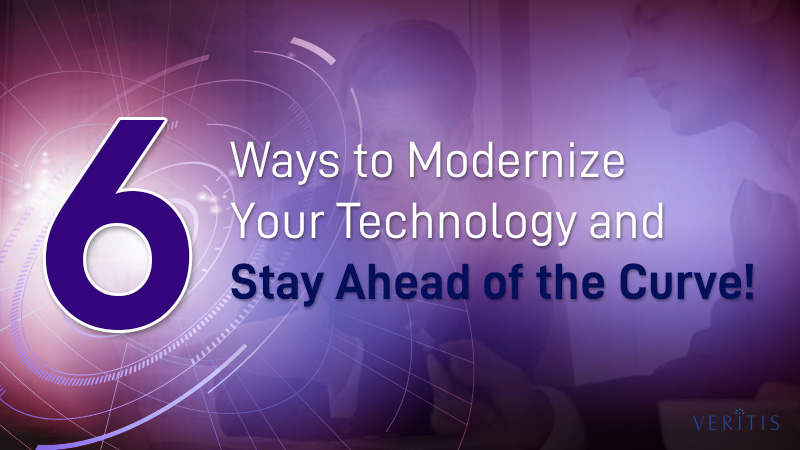
Organizations constantly face a standard question, ‘How do we stand out from the rest’? Stiff competition constantly keeps organizations on their toes, forcing them to continually improve service delivery, retain their existing customer base, and attract new ones.
This is impossible with a stagnant approach characterized by legacy systems, outdated technology, and traditional IT practices. That’s why organizations must familiarize themselves with ways to modernize their existing technology.
Schedule Your IT Strategy Session
Here’s how they can:
1) Customer First

Organizational success and lifespan thrive on customer satisfaction and customer value. The first step to staying competitive is putting the customer first. Creating a strong ‘business case’ is essential when planning an IT modernization roadmap. The business case should clearly define outcomes and explain how each aspect of the upgraded IT infrastructure will contribute to achieving these outcomes, including customer retention, user experience, sales, productivity, and recruiting.
The next step is to collaborate with diverse teams to chart the path of modernization. This includes teams in IT, strategic business development, customer interaction, and operations, all working together in an agile environment to design architecture aligned with common specifications. During this phase, leveraging technical advisory services can provide expert insights and guidance to ensure that the chosen solutions meet the business’s needs and technological requirements. This stage combines strategic insight with agile technology to produce a common goal within a shared reference point.
Recipe for a strong business case:
- Why do we need to upgrade our technology now?
- What problems do we want to solve?
- How will this change deliver value to our customers?
2) Simple Architecture

IT infrastructure is key to any organization, but most of our architecture is haphazard and designed to serve the current needs. This typically results in complex technologies that serve individual applications but cannot be easily evolved or integrated.
However, the new set of platforms has changed this scenario. Standardizing software code and integration standards has enabled applications and systems to interact fully. Tools, including APIs and CRMs, help organizations develop interoperable components that interact seamlessly and share data across the organization’s length and breadth through a common platform.
3) Built for Flexibility and Speed

The complexities of past systems limited their ability to evolve and integrate according to an organization’s growth needs. When organizations needed to scale their operations to focus on more areas, these systems failed to provide the necessary flexibility. Modern-day systems provide these capabilities by accommodating a range of plug-and-play functions for businesses.
The flexibility to design and restructure these new-era systems enables organizations to innovate and add value to business processes and the end-user experience.
Organizations should use the ‘Minimum Viable Product’ (MVP) approach to assess the fitness of new IT systems or upgrades. This approach involves a basic-level installation that includes essential features necessary for estimating the system’s value. The next step is to introduce this system to your employees and a sample group of customers.
This helps you understand customer preferences regarding usability and functionality, and adjust your technology accordingly, thereby enabling the required flexibility and speed for service delivery.
4) With Service as the Center of Focus

While the traditional approach views systems as assets, the modern-day approach treats them as services that a company can channel and integrate to serve its needs (not necessarily owning them). Firms can select and combine them from the best providers, such as Amazon, Microsoft, Google, and more, within their infrastructure framework to suit special business needs.
The key here is that when a company collaborates with a provider to host its offerings, it should look beyond the hardware and software aspects and focus on services benefiting internal functions. These internal functions will ultimately impact the delivery of customer service.
With a service mindset, organizations can establish a value-driven relationship with service providers. By considering providers as ongoing partners in innovation, firms can shift their focus from negotiating terms to jointly generating results with web service providers.
5) Agile and User-Focused

When considering modernization, organizations must aim to avail benefits ‘faster.’ Avoid the approach that aims to deliver an ‘all-in-one systems’ release. Instead, divide the modernization process into a user-oriented approach by introducing usable functions frequently.
It is always better to deliver step-by-step and rapidly than to release service offerings simultaneously and at long intervals. And not to forget that stakeholder (including customers, employees, and all entities connected) feedback is crucial in this process. Using user-feedback-driven frameworks helps organizations achieve agility while remaining committed to the end-user experience.
6) Resources Driven for change

While working to bring about the desired technological transformation, it is essential to consider your organization’s resources and how best to utilize them. You can begin with human resources encompassing strong project management and leadership, followed by financial resources to direct funds only to important areas, especially scrutinizing investments for upgrading legacy systems.
Furthermore, it is important to be selective about external resources such as vendors. It is always best to distribute your data and systems among multiple vendors rather than staying vendor locked-in. It is also important to use open APIs that connect to multiple other systems.
Adapt to the usage of open-source software and make interoperability and integration a critical part of your technology.
Case Study Highlight: Strategic Technology Advisory for an Energy Leader
A major energy storage company engaged Veritis as its trusted technology advisory partner to guide its digital transformation roadmap.
Challenge:
The client lacked a strategic IT blueprint, resulting in a fragmented infrastructure, inconsistent technology decision-making, and limited scalability.
Veritis Advisory Solution:
- Conducted in-depth infrastructure and application assessments, which involved a comprehensive review of the client’s existing IT systems and applications, identifying areas for improvement and potential risks.
- Defined a multi-layered transformation roadmap, including a cloud-first strategy, API-driven architecture, and automation standards
- Advised on best-of-breed technologies and vendor selection
- Facilitated governance frameworks and real-time monitoring KPIs for performance, compliance, and operations, ensuring that the client had clear guidelines and metrics to track the success of the transformation.
Impact:
- Unified technology vision with measurable milestones
- Optimized infrastructure for resiliency, scalability, and performance
- Reduced costs and risk via guided vendor and tool choices
- Established governance and visibility to support ongoing innovation
Explore the full technical breakdown here: Empowering Energy Industry Through Advanced Technology Solutions.
Technology Transformation with the Right IT Advisory
But how will you go about this significant technological transformation without the right insight and guidance to transition from legacy to new?

Technology advisory services are crucial in helping organizations implement the necessary technological transformation and ensure the desired impact on service delivery. Now that you know how to achieve this transformation, Veritis can enhance your experience by providing the proper insight at every process step!
Organizations must develop a step-ahead approach by investing in and employing parameters that drive technological transformation.
Are you looking to innovate? Then, it’s time for a technological transformation!
Got Questions? Schedule A Call
Additional Resources:
- IT Infra Support for Financial Planning and Investment Advisory Services
- Technology M&A with Smart Advisory Services
- Why Data Driven Culture is Important for You
- How to Enhance Security in the Multi-Cloud Era
- Cloud Security Automation: Best Practices, Strategy, and Benefits
- How Agile and IT Service Management can Work Together?
- Business Continuity: Steps To ‘Restart’ Your Stalled Operations!